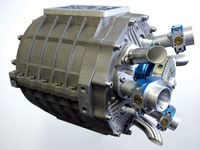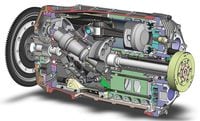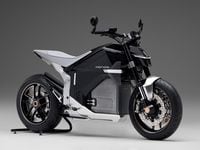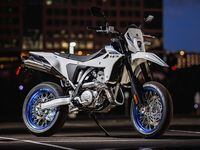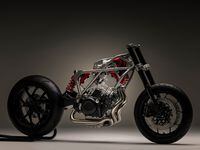The past few decades have seen astounding technological advances in the world of motorcycles—electronic controls that rival fighter jets, space-age chassis construction, exotic materials inside and out—yet the basic properties of the internal combustion engine have remained largely the same. The team at Duke Engines in New Zealand, hard at work on an axial engine prototype , wants to change this.
Duke has been working on its axial engine design for 17 years. The prototype looks nothing like a conventional internal-combustion engine from the outside, and the differences extend inside the cases as well. Five conventional, 200cc cylinders are arranged around the engine’s centerline—with the cylinders parallel to the crankshaft—like chambers in a revolver, for a total displacement of 1,000cc. There are no camshafts, pushrods, rocker arms, valves, or springs—a series of sliding seals similar to a rotary engine take care of intake and exhaust duties. The cylinder group rotates counter to a “Z” crankshaft, at roughly 20 percent of the crank’s rotational speed, to significantly reduce vibration and torque reaction. Power output is competitive; the firm claims 125 hp and 88 pound-feet of torque at 7,500 rpm, the maximum engine speed.
The company is currently working on aerospace, marine, and automotive applications, but the benefits for motorcycle use are many, including significantly reduced engine weight and physical size. Duke says its five-cylinder prototype weighs just 86 pounds and measures roughly 17 x 10 x 10 inches. That’s about two-thirds the weight and half the size of a conventional 1,000cc inline-four. The symmetrical axial design produces little to no vibration, and without a heavy transverse-mounted crankshaft, the Duke engine would have a greatly reduced gyroscopic effect.
Duke’s development process has resulted in significant empirical data that proves its performance on the test bench; now the company is just waiting for investment to bring the design to market. The firm says the most likely first use would be unmanned aerial vehicles (drones) or small aircraft—literally getting the design off the ground. Could a motorcycle application be far behind?
10 Axial Advantages, According to Duke CTO Mike Fry
- Duke DNA—high power density, small size, and low weight—make this engine very suitable for a motorcycle application.
- The counter-rotating cylinder group and crankshaft tend to cancel out gyroscopic reactions. Counter-rotating parts also accelerate/decelerate in opposing directions during firing, reducing the associated torque reaction.
- The Duke engine shape is more akin to the shape of an electric motor, offering a new set of possibilities for design and integration into a motorcycle chassis.
- The Duke engine still uses a conventional gearbox and drive system for easy ratio changes.
- The five-cylinder Duke engine fires three times per revolution of the output shaft—the same as a conventional six-cylinder engine. The smooth power delivery would have less tendency to break traction than the "lumpy" torque delivery associated with four cylinders or less.
- The axial design offers complete primary balance and negligible secondary vibration.
- The internal rotating structure carries the majority of reciprocating inertial loads so the external engine case can be made very light. Think "outer shell," not "cylinder block."
- The output drive shaft can be taken from either end of the engine for maximum packaging flexibility.
- The five cylinders share three injectors and spark plugs as they slide past each in turn. The result is a 1-2-3 firing order as the engine rotates around the three spark plugs in turn.
- The center of gravity of the Duke engine lies on the crankshaft axis, just like a boxer engine or Wankel, and is much lower than in a typical "stand-up" inline layout.

